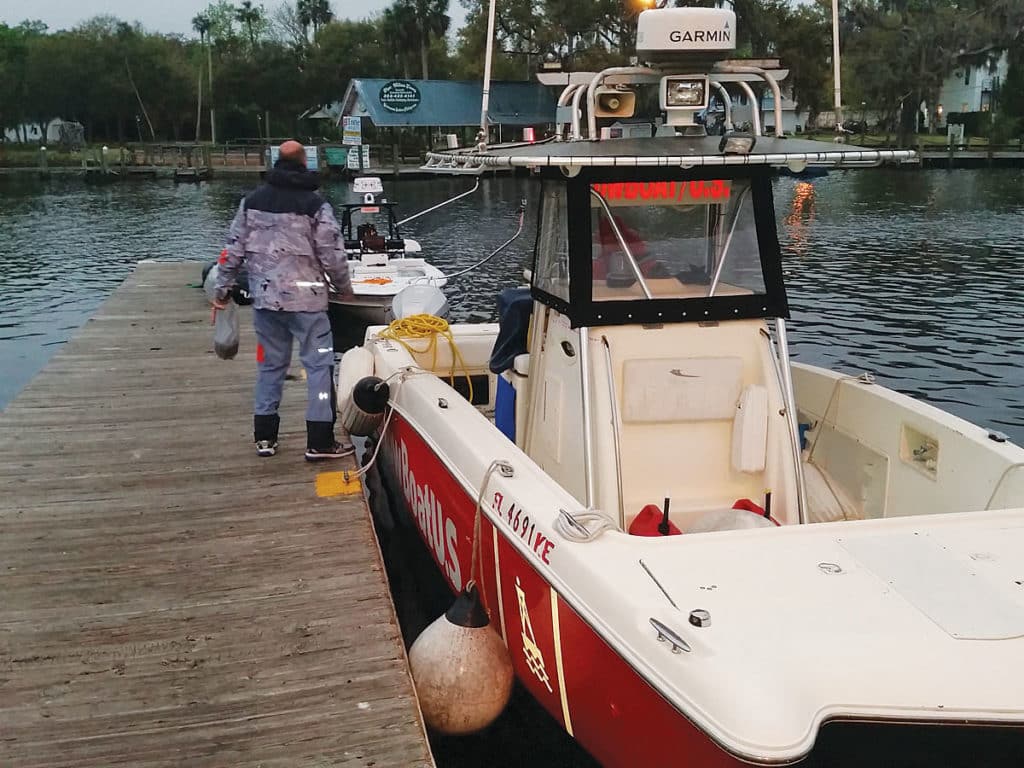To travel around the world in 80 days, a team would average 12 mph every hour for almost three months. Thank goodness Heath Daughtry and his crew from Yellowfin Yachts only had to average 25 mph every hour for two days … in a 17-foot flats skiff … with a 60-hp outboard … partly in open ocean … in early March.
In the company’s first-ever Florida Skiff Challenge from March 5 to 7, the team attempted to travel 1,200 miles — from Pensacola around the Keys to the Okeechobee Waterway, crossing Florida to Sarasota — in 48 hours.
“It has always intrigued me what guys have done in small boats,” says Heath Daughtry, Yellowfin’s vice president, citing Flip Pallot’s crossing to Walker’s Cay, Bahamas, in a 16-foot skiff, and the tales of Everglades frontiersman Totch Brown. “This was something I’ve always wanted to do. We wanted to demonstrate what small boats can do.”
Open Invitation
Turns out, the team and its skiff did 930 miles. They endured cold, drenching storms and high seas, a problematic prop, an engine breakdown, and overwhelming fatigue, finally hauling out in Miami after almost 60 hours.
“I’ve never had hypothermia, but if I was ever close to it, it was in Miami, Florida,” Daughtry says. “We were very disappointed we didn’t meet our goal.”
But while the challenge of 2015 fell short, the Yellowfin crew has started planning for 2016. “Going forward, I would love to make it somewhat of a competition, if not a charity run,” he says, adding that the next trial could also involve fishing.
Daughtry issues an open invitation to competing boatbuilders who might sponsor a skiff and team for the challenge, which he characterizes as an adventure race. He plans to take applications and select only those with the right stuff. “This is not open to the ham-and-eggers,” he warns. “This needs to be exclusive. You have to be a bit savvy about winds and tides.”
The price tag for the trip should average $3,000 to $5,000. Daughtry hopes the challenge boosts the visibility of flats skiffs while promoting the state of Florida, and even raising money for a cause. The drawing board stands blank and available.
Chase Daniel, skiff co-pilot and Yellowfin’s offshore production manager, echoes Daughtry’s indomitable spirit: “I think we can absolutely make it all the way. I’m building my own 17 right now. Whether Heath and I are on the same team or if we have two teams next time, I’ll do it.”
Pre-Trip Planning
That’s saying a lot, considering everything this crew endured as well as everything they did to create the opportunity. Choosing a boat came first. While all four team members work for Yellowfin, that actually didn’t make the choice routine. A brand-new skiff and new outboard need breaking in before such a run.
“We had a customer locally with a 4-year-old [Yellowfin 17] and about 320 hours on the motor,” Daughtry says. “We derigged the console, pulled out a lot of old wiring and rewired the boat.” They fully serviced the Mercury 60 BigFoot outboard.
The team installed new Simrad electronics, including an NSS12 evo2 and two NSS9 evo2 multifunction displays, plus 4G radar and a FLIR M-324 thermal camera, the latter two units mounted atop the poling platform. “The initial plan was to have redundancy. We knew we would take a lot of spray. We wanted at least two screens. My partner went a little overboard,” Daughtry says.
To further enhance nighttime runs, they carried a 10-inch Rigid Light Bar, and to document the trip, they made welded-aluminum GoPro mounts and set multiple cameras to capture an image every 60 seconds.
Besides Daughtry and Daniel aboard the skiff, the team needed a chase-vehicle driver and a multimedia specialist. They planned to post to a public Facebook page throughout their adventure, and carried a SPOT device so they could upload a breadcrumb trail to a shared page and social-media sites.
Guillermo Nazario, Yellowfin’s rig-shop manager for the bay-boat/skiff section, functioned as the mechanic and primary driver for the Ford F-150 tow vehicle. Rusty Driver handled communications and drove a portion of the way. “Before we left for the trip, we planned out where we were going to stop every time,” Nazario says. “Each time, we’d stop and get food. And after we fueled them up, we’d get all the photos and videos from the boat and send them to the website. It was kind of like a pit stop in NASCAR.”
Stumbling Start
The team planned an early-March launch because of the predominant northwest winds — even embracing the additional threat of severe weather as an extra challenge — and because water levels would be high enough that the Okeechobee Waterway locks would remain open.
“We took the boat out and ran 20 miles to get our fuel economy and distance. The only thing we had on board was a gas gauge, no digital readout. We knew if we left the motor with the same prop, we could keep the boat under 5,000 rpm, and that would give us 5 to 5½ mpg, depending on the seas,” Daughtry says. “If we got off-course 20 miles, in a little boat with small fuel capacity, that’s a serious conversation.”
Daughtry set a safety zone of 80 to 90 miles per leg between fuel stops and planned to hold the throttle at 4,800 rpm whenever possible.
The team picked the farthest west public boat ramp in the state — in Gulf Breeze, Florida, near Pensacola — for the launch. The golden rule: Once the boat entered the water, it had to remain in the water. Once the boat came out of the water, the challenge ended.
“When we pulled up to launch, the fog was so thick, we couldn’t see past the ramp,” Daughtry says.
In the parking lot, they swapped out the original prop, which they considered slightly underpitched, with a four-blade prop they had brought. They launched at about 7:30 a.m.
“We pushed the throttle down, and the prop was not adequate for the boat. We ended up spending the first few minutes of the challenge at the ramp. Chase took off his foul-weather gear and hopped in the water to change the prop back.”
Daughtry and Daniel carried boxes full of fuses, connectors and anything that could be affected by corrosion during the trip. They also brought a cooler with water and drinks to stay hydrated, plus safety gear including an EPIRB and handheld VHF radio. The chase truck would bring food and dry clothing.
Winter Weather
Daughtry took the helm for the first leg. They ran along the back side of Pensacola Bay, all the while knowing a front was bearing down on the region. They had only made 20 miles when the wind picked up. “We started heading to shorelines and stayed tucked in, however shallow we could run. We had a high tide.”
Nearing Santa Rosa, the fog lifted and Daughtry could see open water in Choctawhatchee Bay. They headed toward the barge canal and West Bay. “One of the things that had the biggest impacts on me was watching the landscape change,” Daughtry says. “The big pine trees, the hills … the rock and landscape is totally different.’’
Emerging from West Bay into the Panama City area, the crew made its first stop, which lasted a matter of minutes. (The average stop lasted 12 minutes.)
By the time they reached the mouth of Apalachicola Bay, the front fully engulfed them. “The first part of the trip was a true taste of Mother Nature,” Daughtry says. “We had been protected in canals; we had taken some wind but nothing huge. In Apalachicola Bay, it started raining sideways, and the waves picked up.”
They took massive spray but pushed through, making a second fuel stop at Lanark — at the edge of the Big Bend — as dusk approached. “We knew we were about to go into the night. We changed clothes and called home,” Daughtry says. “Then we set out.” The team faced a key choice: hang along the shoreline of the bend or cross the open ocean, running 61 miles to Steinhatchee. They headed into the ocean. Total blackness. No cell service.
At the deepest part of the crossing — when the water depth measured 50 to 60 feet — the front that had passed them going east stopped and turned south. They felt rather than saw the weather approach. (Without much elevation for the radome, its range remained limited.) “We had a lot of chop with white water on top. On two occasions, the boat came off the back side of a wave and dropped. One time, we went up the front face of a wave and the boat stood up. We went airborne.”
Finally, after about 8 p.m., they arrived in Steinhatchee to meet their land crew and enjoy a hot meal. The brief relief revived them. Daughtry took a position ahead of the console in a beanbag chair, and Daniel took the wheel.
Outboard Ordeal
The next stop should have been Spring Hill, but outside Homosassa — at 1 a.m. — the engine stalled. Daughtry first thought they had bought bad fuel; checking the fuel-water separator, he saw a little water. But when trying to restart the outboard, they realized the problem related to low voltage. They tried pull-starting the motor. Nothing worked. They had no cellphone coverage. They were out of handheld-VHF range.
Luckily, the wind was blowing them to the southeast. Dead in the water, they waited until the boat drifted closer to shore. Finally, about 5 miles out, they reached the land crew, who called TowBoatUS with the skiff’s coordinates.
After the boat was towed to a Homosassa ramp, the team convened. And while the boat remained in the water, they began troubleshooting. “It turned out it was a 25-amp fuse on the motor,” Daughtry says. Nazario and Driver bought a battery at Wal-Mart and installed that to replace the dead one. Eight hours later, with morale down and growing tired, they motored out of Homosassa.
After a stop at Anna Maria Island, where they encountered an unfriendly marina operator, they headed down the Intracoastal through Sarasota Bay. As they approached the north bridge to Siesta Key, Daughtry saw three boats anchored at the end of a no-wake zone; they held signs encouraging the team.
“I had no idea people were really following us. People had come out to support us,” Daughtry says. Later, past Venice, the team saw a family they knew, waving a big American flag. In Boca Grande, a line of boats awaited the skiff. “That gets your spirit back up,” Daughtry says.
Night and Day
As the sun began to set, they fueled up at Punta Rassa and headed toward Goodland. Daniel took the helm to continue into the night. Neither skipper had slept more than a few moments in 36 hours. Daniel described this leg as his most memorable: “We were running the beach at night from Fort Myers to Goodland. When we were coming out of a pass, we ran aground briefly. The channel had shifted.
“Once we were off the beach, I was able to surf the 3- to 4-foot seas. But we came off the back of one, and it was like a five-gallon bucket of water hitting me in the face. It filled up the cockpit. We were still on plane, so the water drained out. But it was kind of a wake-up call to how rough it was out there.”
After the pit stop in Goodland, they ran through the Everglades to Hawk’s Cay by moonlight. Arriving at 4:30 a.m., they power-napped for an hour on the boat, and then headed for Key West.
They rounded the tip of the island and passed the Southernmost Point, where they saw a group of people from the marine industry waiting to cheer them on. They ran back up to the Gulf side, and stopped to visit Capt. Steve Lamp for fuel and for “the best black cup of coffee I’ve ever had,” Daughtry says.
Pushing north, they met the land crew at the Jewfish Creek Bridge. A check of the route showed they had another 16 hours to go. “We had done the hard part of the trip. We would make it to Miami, spend four hours in the Intracoastal, get to the lock canal, make Okeechobee that night, and be home the next day,” Daughtry says.
But the cruel March weather changed their plans.
Overwhelming Odds
Daughtry and Daniel took a beating from Barnes Sound to Card Sound. A full-on 35-knot wind battered them in Biscayne Bay. They took water over the bow; the bilge pump ran constantly.
“That 30-mile stretch of water was probably one of the hardest stretches in my life,” Daughtry says. “We made it up under a tree and basically decided it was time to throw in the towel.”
They called the land crew, which had headed up to Boynton Beach, and routed them back to the Venetian Causeway boat ramp.
“I felt good about doing the Gulf Coast shoreline all the way to Key West. That was an accomplishment in itself. I was pretty happy with that,” Daughtry says. In retrospect, the whole team felt grateful.
“We ate like kings,” Daughtry says. “Bread and peanut butter from Publix tasted like one of the best things I’ve had in life.”
Says Nazario: “It was just something insanely awesome that everybody who loves skiffs would love to try. Rusty and I are ready.”
Daughtry has thrown down the 2016 gauntlet. To inquire about the next Florida Skiff Challenge, call him at Yellowfin (941-753-7828). “We’re really spoiled to live where we live,” he says. “When you take an adventure like this, you’ll be surprised by what you learn about yourself and your surroundings.”
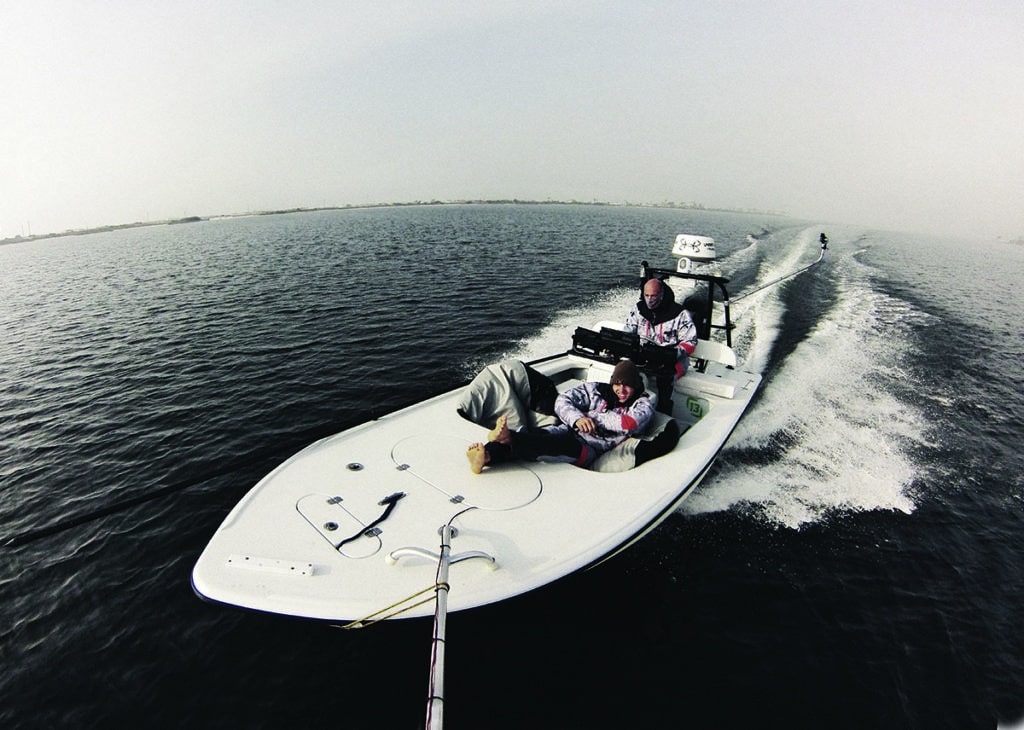
Florida Skiff Challenge
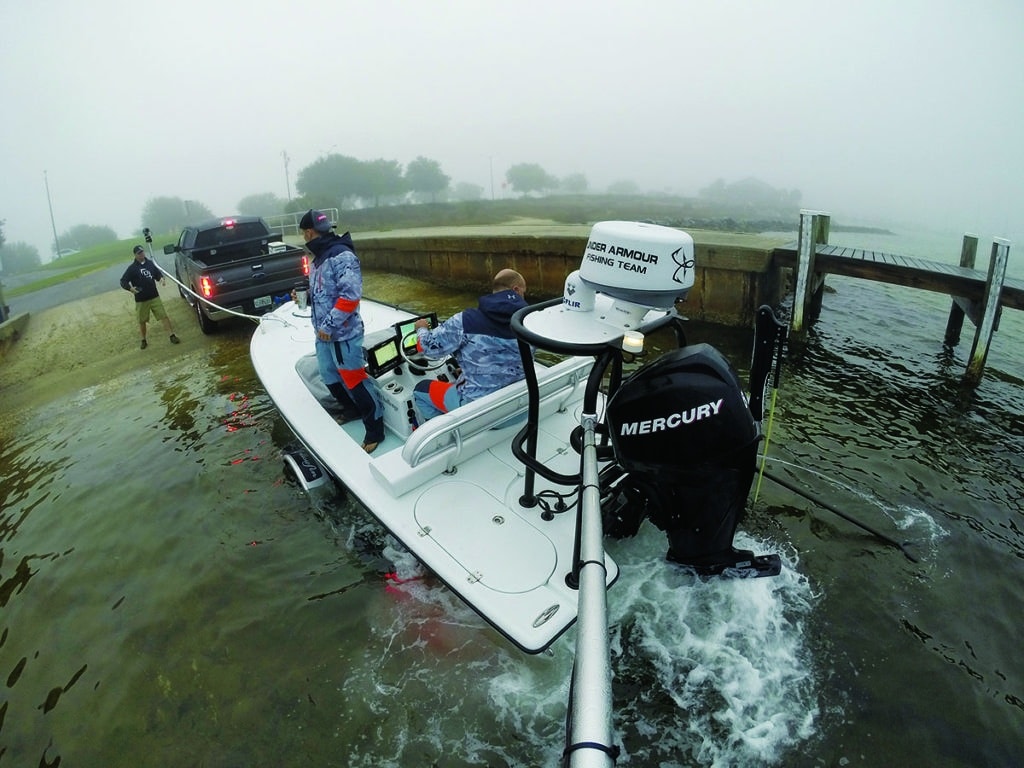
Florida Skiff Challenge
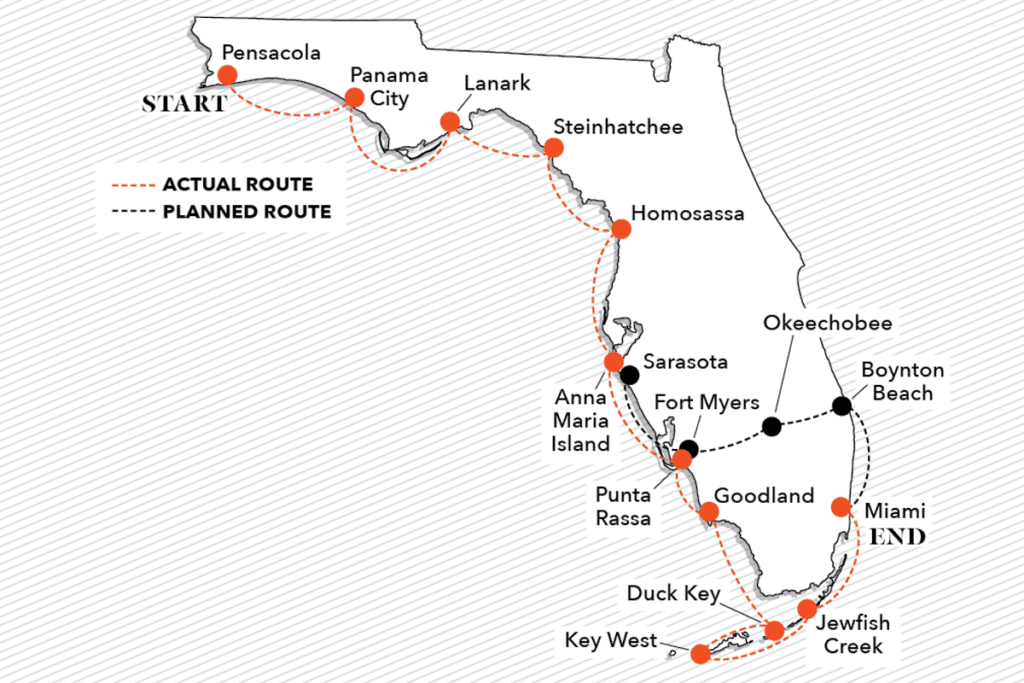
Florida Skiff Challenge
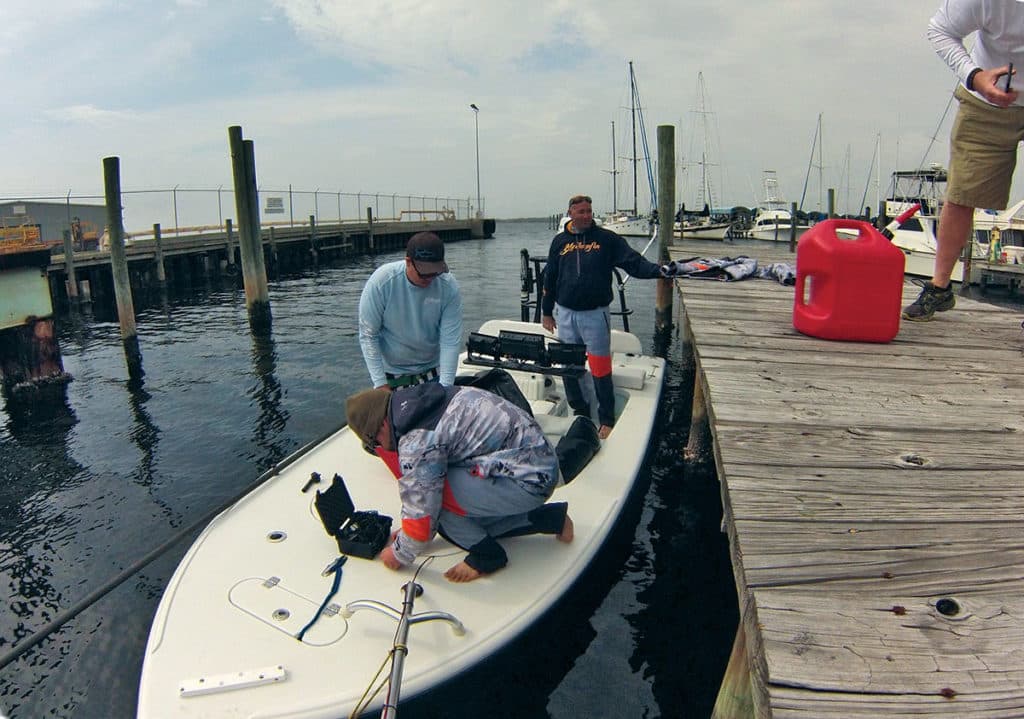
Florida Skiff Challenge
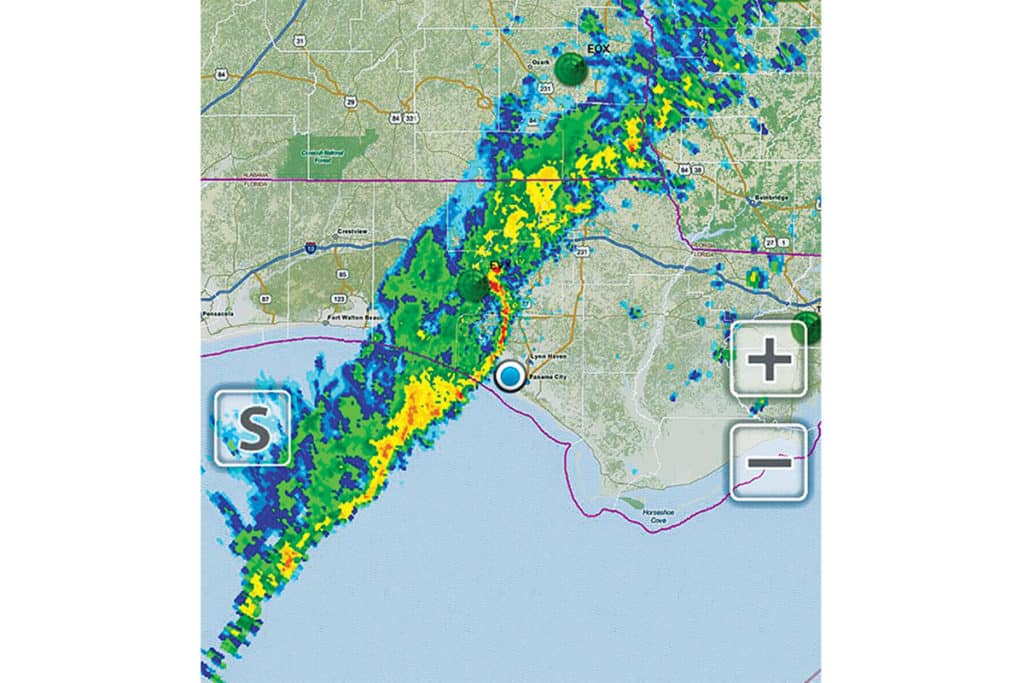
Florida Skiff Challenge
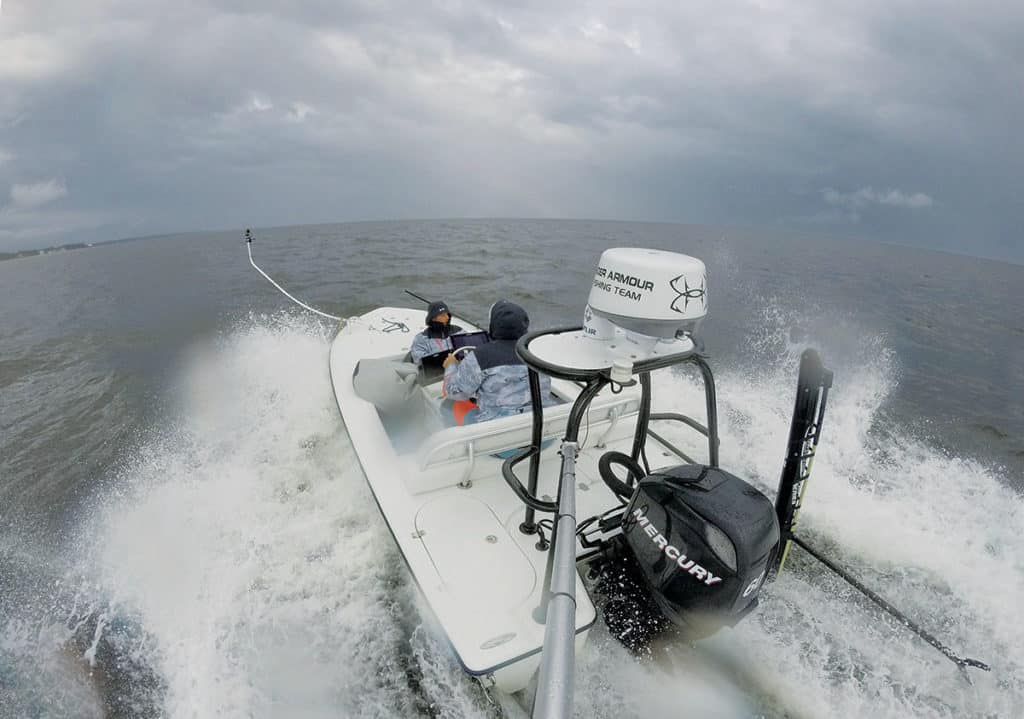
Florida Skiff Challenge
